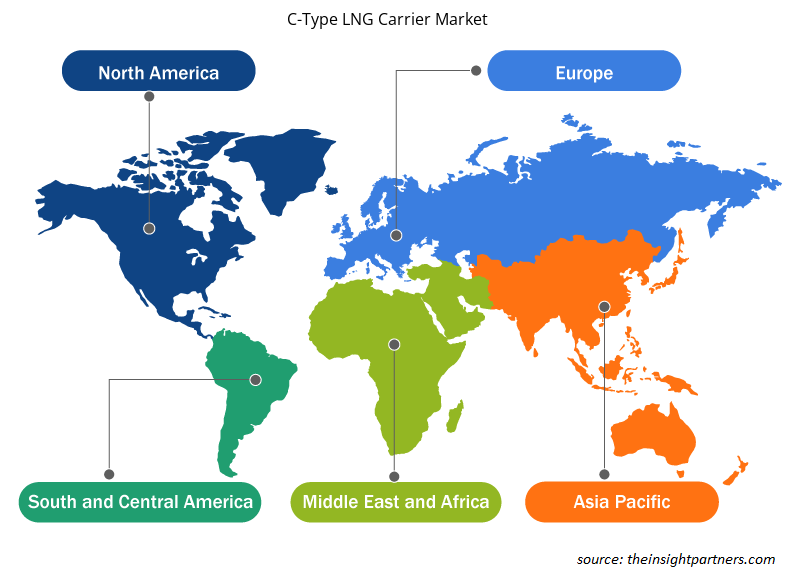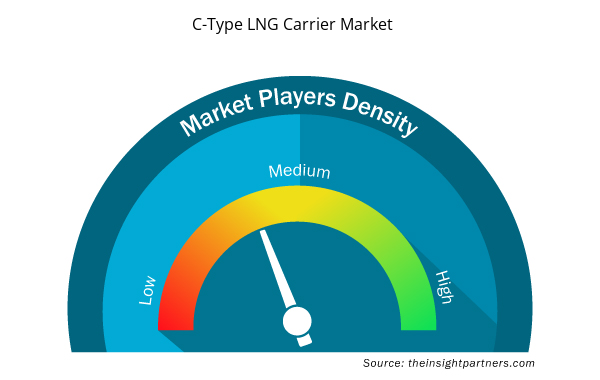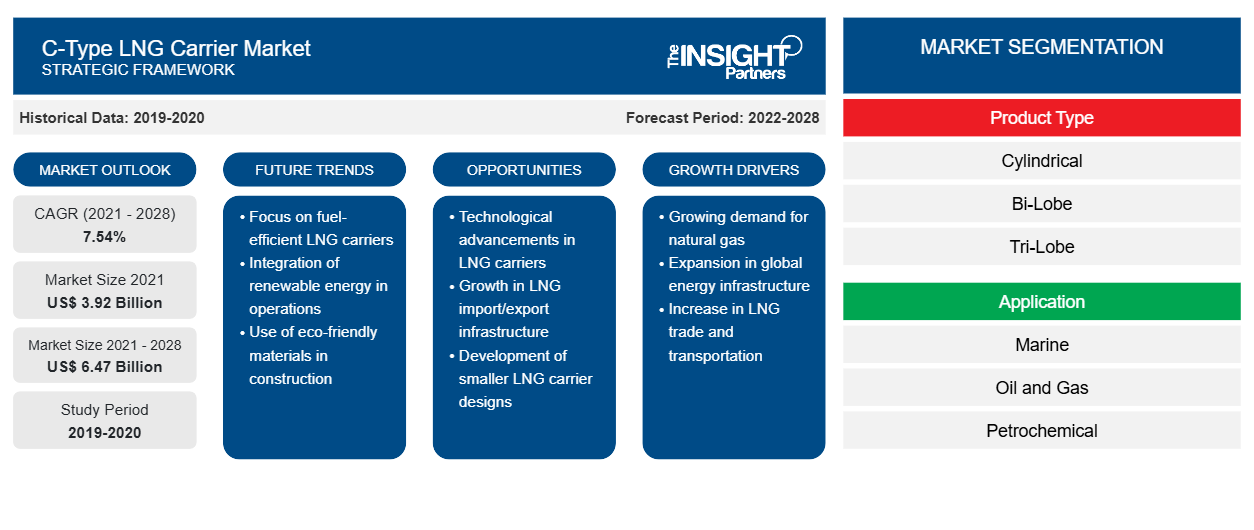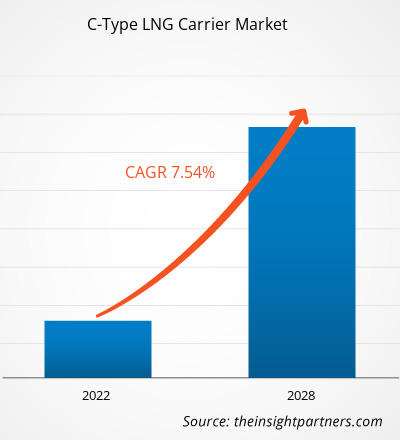2021 年 C 型液化天然气运输船市场规模价值 39.2084 亿美元。预计 2022-2028 年期间的复合年增长率为 7.5%。
C 型罐为绝缘圆柱形、双叶形或三叶形罐,可完全或部分加压,具体取决于要储存的液化气。这些罐可用于小型和中型 LPG 运输船以及小型 LNG 运输船。C 型罐可比 A 型和 B 型罐以更高的压力储存 LNG,不过这些罐的空间优化程度较低。全球许多终端用户(例如发电行业和工业活动)对 LNG 的消费不断增长,这正在提高 LNG 液化能力。新建船舶签约和船队扩张的激增、以及在政府有利的碳排放法规支持下对清洁能源的需求增加,推动了对 LNG 的需求,从而推动了C 型 LNG 运输船市场的发展。能源需求的增长推动了亚太国家对 LNG 的需求。日本、韩国等传统市场在LNG消费方面一直保持领先地位,但由于其国内市场受到自由化政策的影响而发生变化,为LNG运输带来了不同的机遇。
由于对液化天然气运输的需求不断增长,许多行业参与者都期待着建造下一代货物围护系统。2021 年长期合同激增,原因是交易活动在 2020 年下降后有所增加。例如,2021 年,总部位于中国的中石化签署了最多的长期液化天然气合同,每年进口液化天然气 500 万吨 (MTPA);维多集团签署了第二多的长期液化天然气合同,每年进口液化天然气 430 万吨;荷兰皇家壳牌签署了第三多的合同,每年进口液化天然气 400 万吨。根据 Wood Mackenzie 的报告,在未来十年,预计液化天然气需求增长的三分之二将来自中国、印度、巴基斯坦和孟加拉国,这些国家是全球增长最快的液化天然气进口市场。除中国外,印度预计也将在未来几年主导亚洲的液化天然气再气化能力,占2020年至2024年该地区总产能的60%左右。因此,对液化天然气的巨大需求预计将增加液化天然气的运输活动,这可能会推动未来几年对液化天然气运输船的需求。然而,根据国际能源署的报告,到2025年,天然气价格预计将上涨,这可能会阻碍对液化天然气的需求并阻碍市场增长。
定制此报告以满足您的需求
您可以免费定制任何报告,包括本报告的部分内容、国家级分析、Excel 数据包,以及为初创企业和大学提供优惠和折扣
- 获取此报告的关键市场趋势。这个免费样品将包括数据分析,从市场趋势到估计和预测。
COVID-19 疫情对 C 型液化天然气运输船市场增长的影响
COVID-19 疫情对全球 C 型液化天然气运输船市场产生了负面影响。在北美,COVID-19 疫情影响了液化天然气投资以及近期和长期基本面。例如,在美国市场,由于页岩气繁荣,过去十年来 C 型液化天然气的重要性激增。COVID-19 推迟了建造和液化项目,影响了液化天然气运输船的生产,而液化天然气项目可能是削减成本的有吸引力的选择。亚太地区快速发展的经济体对 C 型液化天然气运输船的需求不断增长,预计将成为推动全球经济从 COVID-19 疫情的影响中复苏的关键驱动力。预计印度将与中国一起在未来几年引领亚洲液化天然气再气化能力的增加,占 2020 年至 2024 年该地区总产能的 60.0%。在 COVID-19 疫情期间,液化天然气运输船市场的变化对液化天然气进口国来说将具有重大意义,因为它们可能不得不依赖大型投资组合参与者。如果政府希望在 2025 年以后继续增长,他们可能必须采取更直接的措施。日本承诺向液化天然气基础设施投资 100 亿美元,这是朝这个方向迈出的第一步。一列液化天然气列车的平均成本接近 80 亿美元(400 万吨,每吨 2,000 美元)。所有这些举措预计将推动疫情后 C 型液化天然气运输船市场的增长。
市场洞察 – C 型液化天然气运输船市场
新造船合同激增和新船队扩张
由于对液化天然气的需求不断增长,市场参与者正在建造新的液化天然气运输船。例如,2022 年 1 月,TGE Marine 自豪地宣布江南造船厂两个大型液化天然气货舱的建造阶段已完成。此外,2022 年 8 月,日本邮船宣布与卡塔尔能源公司签订了一份长期定期租船合同,租赁七艘新的液化天然气运输船。两家公司还与现代重工有限公司签订了七艘 174,000 立方米液化天然气运输船的造船合同。因此,领先企业新造船合同的增加正在推动 C 型液化天然气运输船市场的发展。
此外,2022 年 7 月,Gaztransport & Technigaz (GTT) 从其韩国合作伙伴三星重工 (SHI) 获得了一份储罐设计合同,用于设计一系列新型液化天然气运输船。根据合同,Gaztransport & Technigaz (GTT) 公司将设计 14 艘新型液化天然气运输船的储罐。其中两艘船是为亚洲船东建造的,另外 12 艘是为美国船东建造的。同样,2021 年 11 月,江苏扬子江船业推出了以液化天然气为动力的 MSC Washington,该船配备一个 12,300 立方米的 C 型双叶液化天然气储罐。因此,此类液化天然气运输船制造合同和新船队扩张正在推动 C 型液化天然气运输船市场的增长。
C 型液化天然气运输船市场区域洞察
Insight Partners 的分析师已详尽解释了预测期内影响 C 型液化天然气运输船市场的区域趋势和因素。本节还讨论了北美、欧洲、亚太地区、中东和非洲以及南美和中美洲的 C 型液化天然气运输船市场细分和地理位置。

- 获取 C 型 LNG 运输船市场的区域特定数据
C 型液化天然气运输船市场报告范围
| 报告属性 | 细节 |
|---|---|
| 2021 年市场规模 | 39.2亿美元 |
| 2028 年市场规模 | 64.7 亿美元 |
| 全球复合年增长率(2021 - 2028) | 7.54% |
| 史料 | 2019-2020 |
| 预测期 | 2022-2028 |
| 涵盖的领域 | 按产品类型
|
| 覆盖地区和国家 | 北美
|
| 市场领导者和主要公司简介 |
|
C 型液化天然气运输船市场参与者密度:了解其对业务动态的影响
C 型液化天然气运输船市场正在快速增长,这得益于终端用户需求的不断增长,而这些需求又源于消费者偏好的不断变化、技术进步以及对产品优势的认识不断提高等因素。随着需求的增加,企业正在扩大其产品范围,进行创新以满足消费者需求,并利用新兴趋势,从而进一步推动市场增长。
市场参与者密度是指在特定市场或行业内运营的企业或公司的分布情况。它表明在给定市场空间中,相对于其规模或总市场价值,有多少竞争对手(市场参与者)存在。
在 C 型 LNG 运输船市场运营的主要公司有:
- 中国船舶贸易有限公司
- 大宇造船股份有限公司
- 天然气
- 加斯洛格有限公司
- 现代三湖重工业株式会社
免责声明:上面列出的公司没有按照任何特定顺序排列。

- 获取 C 型液化天然气运输船市场主要参与者的概览
基于产品类型的洞察
C 型液化天然气运输船市场根据产品类型和应用进行细分。根据产品类型,C 型液化天然气运输船市场分为圆柱形、双叶形和三叶形。圆柱形部分在 2021 年占据了最大的市场份额,因为它在 50ºC–180ºC 的温度范围内具有灵活性和强度。
C型LNG运输船市场的参与者主要致力于开发先进、高效的产品。
- 2022 年 1 月,现代三湖重工获得了一份价值 13 亿美元的订单,用于建造七艘船舶——六艘超大型集装箱船和一艘液化天然气运输船。六艘 15,000 TEU(20 英尺当量单位)液化天然气动力集装箱船预计将于 2024 年上半年逐步交付给这家总部位于欧洲的航运公司。
- 2022 年 6 月,大宇造船海洋工程公司 (DSME) 与卡塔尔国有石油公司达成协议,获得一份价值 1.07 万亿韩元(8.5 亿美元)的订单,建造四艘液化天然气运输船,并将于 2025 年完成。
C 型液化天然气运输船市场的分析基于产品类型和应用。根据产品类型,市场分为圆柱型、双叶型和三叶型。根据应用,市场分为海洋、石油和天然气、石化和其他。
C 型液化天然气运输船市场分为五大区域——北美、欧洲、亚太地区 (APAC)、中东和非洲 (MEA) 和南美。2021 年,亚太地区以可观的收入份额领先市场,其次是欧洲和北美。C 型液化天然气运输船市场分析有助于了解即将到来的趋势、新技术以及影响市场增长的宏观和微观因素。
C 型液化天然气运输船市场研究中介绍的关键参与者包括 DSME 有限公司;现代重工有限公司;三菱重工有限公司;TGE Marine AG;Gas Entec;Komarine Co.;Torgy LNG AS;中国船舶贸易有限公司;Knutsen OAS Shipping;和现代三湖重工业有限公司。C 型液化天然气运输船市场报告提供了详细的市场洞察,可帮助关键参与者制定增长战略。
- 历史分析(2 年)、基准年、预测(7 年)及复合年增长率
- PEST 和 SWOT 分析
- 市场规模价值/数量 - 全球、区域、国家
- 行业和竞争格局
- Excel 数据集



Report Coverage
Revenue forecast, Company Analysis, Industry landscape, Growth factors, and Trends

Segment Covered
This text is related
to segments covered.

Regional Scope
North America, Europe, Asia Pacific, Middle East & Africa, South & Central America

Country Scope
This text is related
to country scope.
常见问题
The incremental growth rate of the global C-Type LNG carrier market is 7.5%.
The market for C-Type LNG carrier was valued at US$ 3,920.84 Mn in 2021.
Rising Demand for Natural Gas from Several Industries.
The driving factors for the market are:
Growing LNG Liquefaction Capacity Globally
Surge in New Shipbuilding Contracts and New Fleet Expansion
DSME Co. Ltd; Hyundai Heavy Industries Co. Ltd; Mitsubishi Heavy Industries Ltd; TGE Marine AG; and Gas Entec
Asia Pacific (APAC) is anticipated to grow with the highest CAGR over the forecast period.
The country of China is anticipated to hold the largest market share in 2021.
The countries anticipated to grow with the highest CAGR are US, Germany, Japan, Saudi Arabia, and Argentina.
The cylindrical segment held the largest share in 2021.
The market for C-Type LNG carrier was valued at US$ 6,469.02 Mn in 2028.
Trends and growth analysis reports related to Automotive and Transportation : READ MORE..
The List of Companies - C-Type LNG Carrier Market
- China Shipbuilding Trading Co., Ltd
- DSME Co., Ltd
- GAS Entec
- Gaslog Ltd
- HYUNDAI SAMHO HEAVY INDUSTRIES CO., LTD.
- Knutsen OAS Shipping
- Komarine Co
- Mitsubishi Heavy Industries, Ltd.
- TGE Marine Gas Engineering GmbH
- Torgy LNG AS
The Insight Partners performs research in 4 major stages: Data Collection & Secondary Research, Primary Research, Data Analysis and Data Triangulation & Final Review.
- Data Collection and Secondary Research:
As a market research and consulting firm operating from a decade, we have published and advised several client across the globe. First step for any study will start with an assessment of currently available data and insights from existing reports. Further, historical and current market information is collected from Investor Presentations, Annual Reports, SEC Filings, etc., and other information related to company’s performance and market positioning are gathered from Paid Databases (Factiva, Hoovers, and Reuters) and various other publications available in public domain.
Several associations trade associates, technical forums, institutes, societies and organization are accessed to gain technical as well as market related insights through their publications such as research papers, blogs and press releases related to the studies are referred to get cues about the market. Further, white papers, journals, magazines, and other news articles published in last 3 years are scrutinized and analyzed to understand the current market trends.
- Primary Research:
The primarily interview analysis comprise of data obtained from industry participants interview and answers to survey questions gathered by in-house primary team.
For primary research, interviews are conducted with industry experts/CEOs/Marketing Managers/VPs/Subject Matter Experts from both demand and supply side to get a 360-degree view of the market. The primary team conducts several interviews based on the complexity of the markets to understand the various market trends and dynamics which makes research more credible and precise.
A typical research interview fulfils the following functions:
- Provides first-hand information on the market size, market trends, growth trends, competitive landscape, and outlook
- Validates and strengthens in-house secondary research findings
- Develops the analysis team’s expertise and market understanding
Primary research involves email interactions and telephone interviews for each market, category, segment, and sub-segment across geographies. The participants who typically take part in such a process include, but are not limited to:
- Industry participants: VPs, business development managers, market intelligence managers and national sales managers
- Outside experts: Valuation experts, research analysts and key opinion leaders specializing in the electronics and semiconductor industry.
Below is the breakup of our primary respondents by company, designation, and region:

Once we receive the confirmation from primary research sources or primary respondents, we finalize the base year market estimation and forecast the data as per the macroeconomic and microeconomic factors assessed during data collection.
- Data Analysis:
Once data is validated through both secondary as well as primary respondents, we finalize the market estimations by hypothesis formulation and factor analysis at regional and country level.
- Macro-Economic Factor Analysis:
We analyse macroeconomic indicators such the gross domestic product (GDP), increase in the demand for goods and services across industries, technological advancement, regional economic growth, governmental policies, the influence of COVID-19, PEST analysis, and other aspects. This analysis aids in setting benchmarks for various nations/regions and approximating market splits. Additionally, the general trend of the aforementioned components aid in determining the market's development possibilities.
- Country Level Data:
Various factors that are especially aligned to the country are taken into account to determine the market size for a certain area and country, including the presence of vendors, such as headquarters and offices, the country's GDP, demand patterns, and industry growth. To comprehend the market dynamics for the nation, a number of growth variables, inhibitors, application areas, and current market trends are researched. The aforementioned elements aid in determining the country's overall market's growth potential.
- Company Profile:
The “Table of Contents” is formulated by listing and analyzing more than 25 - 30 companies operating in the market ecosystem across geographies. However, we profile only 10 companies as a standard practice in our syndicate reports. These 10 companies comprise leading, emerging, and regional players. Nonetheless, our analysis is not restricted to the 10 listed companies, we also analyze other companies present in the market to develop a holistic view and understand the prevailing trends. The “Company Profiles” section in the report covers key facts, business description, products & services, financial information, SWOT analysis, and key developments. The financial information presented is extracted from the annual reports and official documents of the publicly listed companies. Upon collecting the information for the sections of respective companies, we verify them via various primary sources and then compile the data in respective company profiles. The company level information helps us in deriving the base number as well as in forecasting the market size.
- Developing Base Number:
Aggregation of sales statistics (2020-2022) and macro-economic factor, and other secondary and primary research insights are utilized to arrive at base number and related market shares for 2022. The data gaps are identified in this step and relevant market data is analyzed, collected from paid primary interviews or databases. On finalizing the base year market size, forecasts are developed on the basis of macro-economic, industry and market growth factors and company level analysis.
- Data Triangulation and Final Review:
The market findings and base year market size calculations are validated from supply as well as demand side. Demand side validations are based on macro-economic factor analysis and benchmarks for respective regions and countries. In case of supply side validations, revenues of major companies are estimated (in case not available) based on industry benchmark, approximate number of employees, product portfolio, and primary interviews revenues are gathered. Further revenue from target product/service segment is assessed to avoid overshooting of market statistics. In case of heavy deviations between supply and demand side values, all thes steps are repeated to achieve synchronization.
We follow an iterative model, wherein we share our research findings with Subject Matter Experts (SME’s) and Key Opinion Leaders (KOLs) until consensus view of the market is not formulated – this model negates any drastic deviation in the opinions of experts. Only validated and universally acceptable research findings are quoted in our reports.
We have important check points that we use to validate our research findings – which we call – data triangulation, where we validate the information, we generate from secondary sources with primary interviews and then we re-validate with our internal data bases and Subject matter experts. This comprehensive model enables us to deliver high quality, reliable data in shortest possible time.


 获取此报告的免费样本
获取此报告的免费样本